Cervical osteochondria is a disease that is difficult to diagnose when the patient's initial treatment in the doctor due to a large number of signs and a slower course of the disease.
Development and manifestation of pathology
The cervical spine osteochondria is found in people who lead a sedentary lifestyle and have a living room.
Signs
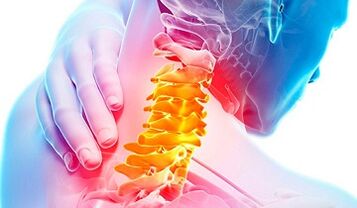
The signs of cervical vertebrae osteochondal are not only pain in the cervical area and in the upper shoulder belt, but also headaches, chest pain.
Several syndromes are distinguished, each of which is characterized by its own marks.
The Rooser Syndrome is due to a pinch of nerve endings in the intervertebral space of the cervical spaces.Features:
- pain in the cervical area.
- Pain in the forearm and hands.
- The senses of the sting, numbness in the forearm.
Cardiac syndrome (or heart syndrome) is due to infringement or irritation of the roots of the diaphragm and (or) large thoracic muscle.In this case, the signs will serve as pain in the area of the heart, which will be long and sharp in the event of a rotation of the head, sneezing or other neck movements (as in the case of angina).
Vail ARTERY syndrome.The signs of osteochondry in this case will be:
- Pulse headaches in the occipital, frontal (above the eyebrows) and the time part, which are constant.
- Hearing disorders, vestibular device, vision (when cervical vertebrae can be osteochondria).
Ristritive-Reflex syndrome.The signs of such a syndrome are:
- pulsating pain in the occipital part of the head.
- Pain in the cervical section, passing even lower to the chest or spreads to the side, to the shoulder joint.
- Enhance the pain after sleep, the sharp movements of the head (including sneezing, cough).
Symptoms
Symptoms with the development of osteochondria depend on which nerve root is damaged.In the cervical area of uterus 7, including nerves.Their damage causes pain in the development of osteochondicism.

The vertebrae are considered from top to bottom and indicated by Roman numbers (CI, CII).The nerve endings between them are considered similar and are defined by Arabic numbers (C1, C2).The letter C denotes part of the cervix (from Lat.
- In the event of damage to the nervous end between the first and second vertebra (C2), the main symptom will be numbness and loss of sensitivity to the occipital part.Later - pain there.
- Nervous termination damage (C3) between the second and third vertebra leads to impaired sensitivity to the area and later leads to weakened sensitivity and reduced language (until speech impaired).
- Damage to the nervous end between the third and fourth vertebra (C4).In this case, the pain focuses on the claw, passes on the area of the heart and can be breathing.But the pains precede a feeling of numbness in a collar and shoulders.
- Damage to the nerve root of the C5 between the fourth and fifth vertebra.In the event of damage, it responds to the impairment of the sensitivity of the limbs, both the upper (the hands) and the lower ones, as well as the pain in the forearm and the outside of the shoulder.
- Nerve damage ending in the area of the fifth, sixth and seventh vertebra (the most common cervical osteochondria).The symptoms of nerve endings of the C6 and C7 nerve endings are periodic numbness of the fingers and hands, the pain in the throat, the forearm and the bottom - the shoulder blade, back, to the lumbar.
- Damage to the nerve C8.The pain is concentrated on the neck and spreads through the forearm to the elbow and back to the lower extremities.The pain is preceded by the loss of sensitivity to important areas of the hands (fingers, brushes), feet (fingers, legs), skin.Blood circulation to the extreme is disturbed, which affects the color of the skin of the hands and feet.
Reasons
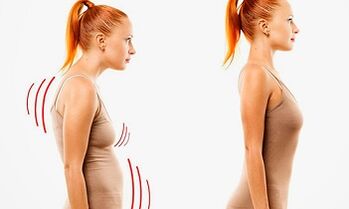
The cervical osteochondria is increasingly found in the young population.The reasons for explaining the appearance of the disease are more commonly due to the wrong lifestyle than hereditary predisposition.
Among the inheritance causes, not only a genetic predisposition to the disease, but also the presence of chronic diseases, hereditary abnormalities of spine development.
The list of causes of cervical vertebrae osteochondic vertebrae is very wide.These include:
- Inappropriate nutrition and, consequently, excess body weight, a disturbed metabolism in the body, the lack of vitamins and minerals.
- A sedentary lifestyle caused by a meeting or uniform work.Unstable physical activity.
- Severe physical activity.This includes professional sports, frequent weightlifting.
- The curvature of the spine, the breach of the posture, the consequences of spine injuries, developed flat legs.
- Stress, frequent nervous pressure.
Diagnosis
The diagnosis of osteochondry should only be made by a doctor.
Visual diagnosis
When he comes into contact with a neurologist and an orthopedic doctor, a patient's examination and research will initially be conducted.After palpating, evaluating the mobility of the throat and degree of pain, the patient will aim to diagnose material.
Radiography
The method will help detect changes in the cervix area and determine their degree.For a more precise diagnosis, it is possible to use functional radiography when images of the cervical spine are taken at various postures, which help to "conceive" of changes in the intervertebral from various sides.
Tomography of magnetic resonance
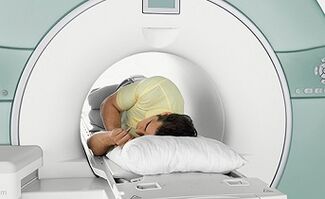
The method that uses magnetic pulses to obtain a tomography, in which we can diagnose not only pathologies in the structure of vertebrae and intervertebral cartilage, but also determine the presence of intervertebral gardens, size and location.
When the magnetic resonance imaging is used in the results of the diagnosis, the changes will be visible to the vascular system and the nerve endings of the spine.
Computed tomography
This is a detailed analysis of the condition of the vertebrae using a computer tomography and processing of the result.The method allows not only to detect changes in vertebrae and intervertebral spaces, but also to analyze the condition of soft tissues, blood vessels and joints.
Diagnosis
After being sent to one of the diagnostic procedures, the doctor will make a differential diagnosis - it will exclude the presence of other diseases in the body that have similar symptoms.This will require a blood test, a reference to other medical experts.
What is dangerous to ignore osteochondria?
The cervical osteochondria has periods of recession and deterioration.Often unhealthy people, without going to the doctor in time and using painkillers, feel relief and forgetting the problem until the next deterioration.But the disease continues to develop and, if you continue to ignore the obvious symptoms, can lead to serious complications in the cervical area.
Among the first and therefore, there are relatively "mild" consequences of the onset of cervical osteochondicity, the protrusion and the hernia of the intervertebral discs are distinguished.
In the first case, the intervertebral disc is protruding, its shift from the normal position between the vertebrae.At the same time, the connection fibers in the intervertebral disc (fibrous ring) remain intact and intact.
The condition in the cervical spine is severe even up to 1 mm in size, while in other parts of the spine these changes are not so dangerous.
After forming the protrusion, the destruction will affect the fibrous ring - connecting the fibers that protect the inner jacket of the core of the pulp.The pathological changes in these structures lead to the formation of the intervertebral disc hernia.The formation and development of the hernia is accompanied by the increase in pain syndromes and the unpredictable consequences.
The most serious consequences of osteochondrication, if there is no treatment, are vascular disorders: vegetable dystonia, hypertension and hypotension.
The formation of the intervertebral disc hernia leads to a violation of the correct position and function of blood vessels, compressing the arteries that feed the brain.This leads to a violation of oxygen intake in the brain and its normal work, contributes to the formation of blood clots in further gaps.The result of the development of the disease is a stroke.
First aid
With the deterioration of osteochondry, the first question the patient faces: "How will he get rid of the pain in the cervical area?"
Medicines containing analgesics, as well as painkillers, will help remove pain sensation and limit movements will help moves.
When acute aches pass, in the coming hours and days before moving to the doctor they can use anti -inflammatory painkillers.During periods of decline in frenzy, you can use heating ointments, will help you relieve the throat tension and distract from painful pain.The ointments should be applied with massage -free light movements.
If an attack on cervical spine pain found you away from the first kit -aid, such means as a fitter, a pepper dealer, mustard and sand bag can help.
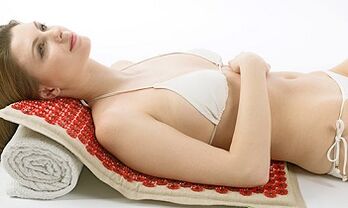
The applicator must be placed on a flat surface, located on it, so that it is below the cervical part of the uterus, the occipital part of the head and the shoulder joint.A few minutes should suffer skin pain.The lying in the application should be 2-3 times a day for 30-40 minutes.
Pepper patch or mustard, you can use a bag of hot sand, you should apply to the sly spot on the neck, leave for several minutes.Heat will relax the muscles and distract the irritation from pepper or mustard from the pain.
Exercises from exercise therapy (physiotherapy exercises), recommended for cervical osteochondria, are able to reduce pain, but in a meager period.Exercises should be done regularly during periods of recession - this will help rapidly therapy and reducing the severity and frequency of the effects of the disease.
After receiving first aid and remove the pain, you should seek help from doctors as soon as possible.
Treatment
The treatment of osteochondry is performed using different methods.
Traditional medicine
The popular and effective is drug treatment.
Medication
Anesthetic tablets are used during the period of deterioration of osteochondrication and are more suitable for an ambulance for the patient.In such cases analgesics are used.
Treatment is performed by other drugs -NO -Introductory anti -inflammatory drugs (NSAID).
Modern medicine uses a new type of medicine - chondrop protectors - drugs that restore the cartilage tissue.
During the deterioration of the disease, when the pain syndrome may be very severe, doctors prescribe injections that not only relieve pain but have anti -inflammatory effect.
Blocking the pain syndrome
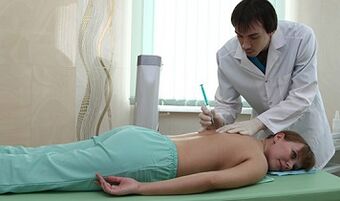
In advanced cases, during the worsening of the pain syndrome, it can be resistant to analgesics and even in injections of painkillers.The doctor can then be performed by SO - called "blocking" - the introduction of an anesthetic drug into a source of pain using an injection.Thus, the painful part of the spine is "disconnected" from the general nervous "composition" and for some time (depending on individual characteristics) the pain from this area does not disrupt the patient.
An experienced medical staff must necessarily perform the process, since an incorrectly integrated procedure can lead to complications.The exclusion itself has no contraindications other than individual drug intolerance and can be done as often as the body requires.
Non -traditional medicine
Osteochondria is a disease that is not so easy to treat, so you need to approach this overall.Acupuncture is used in the treatment of osteochondrication.
Acupuncture is not a method of traditional medicine, but it has been established in the fight against osteochondry in allowing you to relieve the pain and can be used in periods of frenzy.We have to remember that it does not bring acupuncture as such, reduces symptoms, helps in easier to transport periods of deterioration of the disease, improves throat and joint mobility, and rehabilitation and regeneration processes activated by the exposure contribute to the speedy recovery.
Physiotherapy
In addition to drug therapy, doctors recommend that physiotherapy are performed.

- Electrophoresis.In the case of osteochondrication, electrophoresis is used with non -seroidal anti -inflammatory and analgesic drugs to transfer the drug to the affected area from the point and to the required tumor.Electricity enhances the effect of drugs and the procedure results in treatment.
- ElectrotherapyUsing weak electrical currents and magnetotherapy using a magnetic field.They act in painful areas, relieving pain, improving blood circulation.It helps during periods of recession and activates cell regeneration processes, accelerating the healing process.
Other physiotherapists aim to increase the bloodstream of a painful region, reducing edema and inflammation, pain and general enhancement of body immunity during treatment.
Ointments
The use of ointments for osteochondria is not the main method of treatment and is prescribed as an additional measure that contributes to the rapid recovery.The ointments used can be divided into different groups.
- Painkillers and anti -inflammatory.Such ointments include analgesic and steroidal anti -inflammatory substances.
- Interpretation of ointment.The main ingredient of such ointments has an irritating effect on the skin, which increases blood supply to the area.This relieves stress, edema, reduces pain.
- Protectionin the form of ointment.Active substances restore cartilage fabric and auxiliaries are relieved of inflammation and pain.
- Massage ointments.The ointments used for massage and self -peculiar.There are natural anti -inflammatory substances, analgesics, a complex of regenerative substances of plant origin.
Massage and self -mast
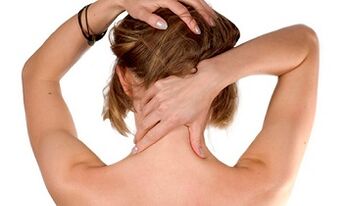
Cervical spine massage is essential during periods of recession of the disease in order not to increase the pain during the procedure.The massage is prescribed by a course of ten to fifteen sessions and is not held more than once in the fourth.Massage for cervical osteochondria is used as a process that enhances the effect after treatment and for the prevention of osteochondry.
The massage of the belt for collar and the acoustics, at the distribution of the disease, is done by a specialist.Clear massage movements help to knead the throat muscles, improve blood circulation, relieve tension and after massage, enhance the neck muscles, which will maintain the preventive effect for several weeks and even months.
If necessary, you can perform yourself a light massage.It is necessary to knead and grind the throat muscles, the muscles of the fibrous part and the shoulders on the back.Simple movements in a convenient position and at any time can be an addition to the treatment and prevention of cervical spine.
Self -assessment is recommended for several minutes a day, no contraindications, and the pain, if accompanied by movements, is easily controlled by the patient alone.
Nutrition
In addition to classical treatment, physiotherapeutic processes and massage, for the treatment and prevention of cervical spine, it is necessary to properly nutrition with a full range of vitamins and minerals.

The gentlemen in this issue are vitamins A and C, reinforcing the vessels.Vitamins B6 and B12 improve metabolism and amino acids in the body, help the nervous system function properly and without failures.
Complex vitamins are essential during the recession period for general rehabilitation and strengthening of the body.
Traditional medicine
Folk remedies for the treatment of cervical osteochondicity are divided into those that relieve pain and can be used for exacerbations and those used by lessons for several days or even weeks and have a therapeutic effect of long -term action.
Compression of potato anesthesia
You will need:
- potato;
- Honey-1-2 Tbsp.Spoons for a potato.
Preparation and application:
- Clean the raw potatoes, grill.
- In a shallow bowl, mix with honey to smooth.
- Put the resulting mass in a sly spot, cover with polyethylene and fasten it with a diaper.Keep compression for 1-2 hours.
Infusion of radish radish for anesthesia
Coloring in folk medicine are used not only for the rubbing of painful plots for anesthesia, but also for oral administration for a general reinforcement and relief effect.
To infusion of radish in the vodka, you will need:
- Black radish - half medium size.
- Vodka-50-70 ml;
- Honey -3-4 tablespoons.tablespoons of soup.
- Salt - 2 tablespoons.tablespoons of soup.
Preparation and application:
- Peel the radish, grill on a thin rub.
- In a shallow bowl, stir until normalized: grated radish, honey, salt, vodka.
- Rub the part of the cervix with the mixture with the mixture 2 times a day during worsening.
- Take inward with an empty stomach for 1 teaspoon 2 times a day during a deterioration.
Ginger analgesic ointment
You will need:
- Ginger powder - 1 tablespoon.spoon;
- Garlic-2-3 plan.
- butter.
Preparation and application:
- Pull ginger powder in a saucepan in a small amount of butter.
- Peel the garlic, grill on a thin rubbing or grind with a crash.
- In a shallow cup, mix the fried ginger powder and garlic until softened.
- The resulting ointment can be rubbed into a painful spot with exacerbations or used as compression, tied with a diaper for a few minutes until a burning sensation on the skin.
Oil with rubbish for rubbing
Petroleum rubbing with light massage for osteochondria is used during periods of recession of the disease and is done with lessons 10-15 days with a break.
You will need:
- Oregano (grass) - a handful;
- Olive oil (can be a sunflower) 300-500 ml.
Preparation and application:
- Punnin (grass) shakes thin.
- Add the oregano to a bottle of oil and let it inject in a dark place for at least one day.
- Pull the oil, also by pushing the oregano from the oil.
- Use the oil infusion to rub and light massage of the location affected by the 1 hour osteochondria.
Night compression by horseradish
You will need:
- HorseraDish Flee-1-3PCs.?
- boiling water.
Preparation and application:
- Dip the kids' leaves for a few seconds in boiling water (soften).
- Apply soft leaves to the place affected by osteochondria, diaper -tied and scarf insulation.
- Leave the compression from the leaves of the horse at night.The feeling of light sting is quite acceptable.
- The procedure is done during the downturn of the disease with a course of 5-7 processes with a break for 2-3 weeks.
Cocktail
You will need:
- Lemon - 1 pc.?
- Garlic-1 heads (5-6 cloves).
- boiling water.
Preparation and application:
- Peel the lemon from the peel, the seeds, grind with a blender or pass through a meat grinder.
- Peel the garlic, grind with a crush or grill on a thin rubbing.
- Mix lemon and garlic in a jar or a large bottle, pour a mixture of 0.5 liters.boiling water.
- Insist the resulting mixture of at least 12 hours (leave one night).
- The resulting lemon-blade cocktail is consumed daily in half a glass on an empty stomach in the morning.
You can store a cocktail in the refrigerator, prepared as needed.The course of cocktail reception is 1 month.
Strawberry
You will need:
- Forest strawberries (fresh or dried) - 1 tablespoon.spoon;
- 1 cup boiling water.
Preparation and application:
- Floor berries pour boiling water like tea.
- Insist for at least 10-15 minutes.
- Drink with osteochondria 2-3 cups a day.
Medical physics
One of the causes of osteochondry is hypotherapy - the lack of physical activity in a sedentary lifestyle.Performing only a few simple exercises will help relieve the deterioration of the disease or prevent its appearance.
Exercises “for home and office”
Resistance
- Pressing the palm on the occipital part of the head, making the throat muscles attempt.With one hand resisting.Maintain a voltage of 10 seconds.
- Change the position of the hand by placing it on the forehead and now try to put forward.It also resisted about 10 seconds.
- Change the position of the hand by placing it with a palm in the temple (right hand to the right temple), it also resists the pressure of the hand on the head.Maintain a voltage of 10 seconds.
- Change the hand and side of the exercise application, now to resist the left (left hand in the left temple).Maintain a voltage of 10 seconds.
- Change the situation alternately by repeating the exercise up to 5 times for each hand position.
Head
- Stand straight, aligning your shoulders.
- Making heads as possible as much as possible to the right and left alternately.
- Lower your head to the chin on the neck.
- Make the same turns with your head as much as possible on each side, slowly and without tearing the chin from the neck.
- Run the exercise slowly, repeat turns up to 5 times on each side in each position.
Slopes
- Rest your shoulders and throw your head back a little.
- Run his head left and right, trying to get to the shoulders with his ear.
- Slowly do the exercise and repeat up to 5 times on each side.
Exercises performed lying down
Lifting the legs
- Lying on your back, stretch your hands and feet freely.
- Put your feet together, pull your knees to your stomach, pulling your head up, trying to get your eyes with your knees.
- Revival, reducing your head and straightening your feet and hands along the body.Repeat, late 5 times.
Turns of the head head
- Lying in the stomach, straightening your feet, place your hands along the body.
- Turn your head to the left, trying to get it to the floor with your right ear, then turn the head to the right, also trying to get to the floor now with your left ear.
- Repeat the head turns up to 5 times in each direction.
When performing all exercises, we should remember that in the case of pain, you should refuse to perform the exercise and consult a doctor.
Prevention
Prevention of cervical spine osteochondination is a healthy lifestyle:
- Physical Education and Sport (Moderate).With the tendency of osteochondry, swimming will be the best assistant.Strengthens shoulder and throat muscles.
- Balanced diet.Include a large number of products containing calcium, magnesium, vitamins (cottage cheese and dairy products, peas and other legumes, nuts, fish and seafood) in the diet.
- Breaks at the meeting.At every opportunity, we try to knead the muscles of the throat and back.
- Excessive load.Do not wear very and often seriousness (including sacks on one shoulder).
- Orthopedic pillows and mattress.Use them if possible.
- Non -fat.Overweight accelerates the growth of osteochondicism.Stand on the scales more often.
To control the condition of the cervical area, it is recommended to diagnose at least once every 2-3 years: conduct magnetic resonance imaging or computed tomography.
In addition, a examination by doctors should be conducted at least once a year: surgeon and neuropathologist.The treatment of any disease is easier and faster if you start when the first signs occur.


























